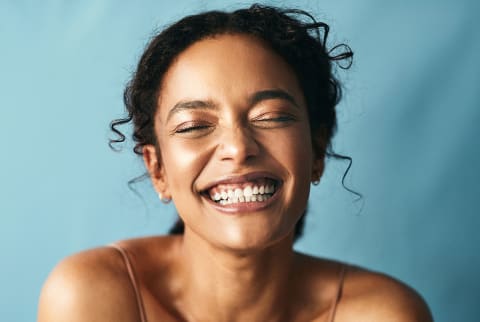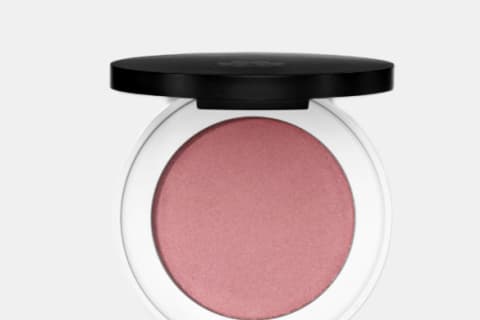The Pandemic Has Transformed Our Relationship With Blush


On my desk, nestled comfortably beside my notebook, I keep a pot of cream blush. Granted, having a makeup product within arm's reach isn't too obscure a habit for a beauty editor, but lip balms, facial sprays, or even brow gels typically reach deskside status—you know, items you can easily reapply right before waltzing into a meeting. And yet, the peachy hue sits by my side (it has for a few months now), ready to glaze my cheekbones at a moment's notice.
Whether others keep their blushers close by I'm not sure, but I'm not alone in my recent affinity for rosy cheeks: According to research collected by the data provider Semrush and shared with the New York Times, blush is the third most popular searched for beauty product in the U.S., and the data science team at Pattern told the publication that consumer demand for blush has seen a steady increase on Amazon, especially compared to other makeup staples.
Advertisement
We prepared for an era of eye makeup (thank you, masks), and yet this color story doesn't just prevail; it blooms.
Why has blush seen such a rise in popularity?
The thing is, we'd argue blush has always been a means of expression, one that ebbs and flows in popularity.
And whenever blush skyrockets in popularity, it's usually during celebratory moments of joy and liveliness: Take the roaring '20s—where you couldn't find a flapper without a concentrated pop of color on the apples; or in the '80s, the so-called age of excess, when blush was grand and larger than life—the rosy hues draping all the way up to the temples. On the opposite end of the spectrum came the counter-movement in the grungy '90s, when it was chic to look pallid and gaunt—as such, a sweep of blush ran out of favor.
And while beauty is cyclical in nature (think curtain bangs and French manis), these makeup moments of grandeur follow a specific cadence: After periods of distress, uncertainty, and trauma (the '20s followed the Great Depression; the Vietnam War ended in '75), people long for joy; they prioritize fun—and so they create it themselves, with a youthful glow.
Why, though, do we celebrate youth by turning to a pot of rouge? Let's take the formula itself: Blush was quite literally made to brighten up your cheekbones, add some warmth to your complexion, and make you look, oh I don't know, alive. (After all, a naturally flushed face represents an influx of oxygen and nutrients to the skin cells.)
So when we crave all things lively and vibrant, of course we'd reach for a blush to help manifest it. "That reach for blush is like a reach for happiness," says celebrity makeup artist A.J. Crimson. "It's a reach for joy."
"Color brings life to the equation," poses celebrity makeup artist Gucci Westman, founder of Westman Atelier. "It makes you think of vibrancy, charisma, optimism...I don't think there's a negative word that comes to mind when I think of blush."
Now, we're entering another renaissance of blush.
It's no coincidence we're seeing blush take back its reign, as we crawl toward the tail end of another historical period of darkness. "We want to get back to life, and blush represents that in our face," Crimson adds. This time, though, the renaissance looks a bit different than the rubescence of decades past.
To start, technology plays a pretty practical role: In our Zoom-dominated era, a sweep of color can help you appear more animated and full of energy while connecting with others via screen. (Hence, why I stow the pan of blush at my deskside.)
Since webcams can oftentimes make you look a bit flat and desaturated, a little blush helps bring back some dimension and warmth: "There's a lack of vibrancy, and I think it's intuitive to go for some color," notes Westman. "It's quick, it's easy, and you can do it last-minute."
And while blush can certainly be fun and loud and bubblegum pink, it's also raw and honest—it translates your mood and puts it on full display, even on a virtual plane. "There's a softness that I think blush also provides," Crimson remarks, a sense of humanity itself that says, We may not meet face-to-face, but I am here with you.
Of course, some eschewed the makeup altogether during quarantine—discovering they can feel bold all on their own, without the help of a bold red lip. But for those who felt inspired to adventure with their beauty bag, blush becomes a relatively low-lift (and mask-friendly, depending on where you apply) product of choice. Read: It takes a bit more time and skill to master a floating liner or the perfect blend of shadow when a strategic tap of cream blush can also lend a whimsical, bright look.
To experiment with your blush, Crimson suggests layering different hues ("like pinks and peaches together") or sweeping the blush all the way up your temples and onto your lids for a monochromatic, '80s-inspired beat. Or, you can always buff a warm shade into your hairline (you may not have lounged on the beach this year, but the faux glow can at least look like you did).
Advertisement
The pandemic has transformed our relationship with blush—just like the historical moments that came before.
This week marks the anniversary of when the World Health Organization officially declared COVID-19 a pandemic1. And after a year plagued by uncertainty and trauma, we crave the vibrancy a pot of blush brings—its resurgence in popularity is no happenstance.
Of course, we're not out of the woods yet by any means, but there is a glimmer of light at the end of the pandemic-sized tunnel. And as beauty history has shown: When we can finally see the light, we match it with a rosy glow.
Shop these products:
Advertisement

Jamie Schneider is the Beauty & Wellness Editor at mindbodygreen. She has a B.A. in Organizational Studies and English from the University of Michigan, and her work has appeared in Coveteur, The Chill Times, and Wyld Skincare. In her role at mbg, she reports on everything from the top beauty industry trends, to the gut-skin connection and the microbiome, to the latest expert makeup hacks. She currently lives in New York City.


